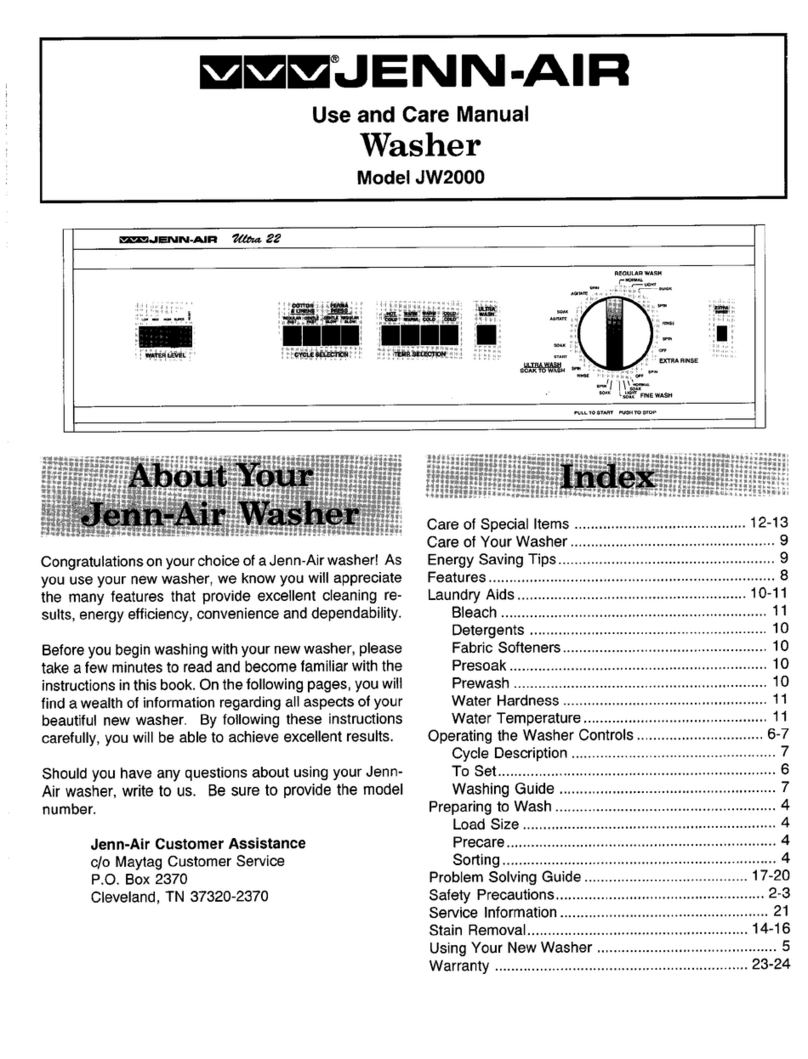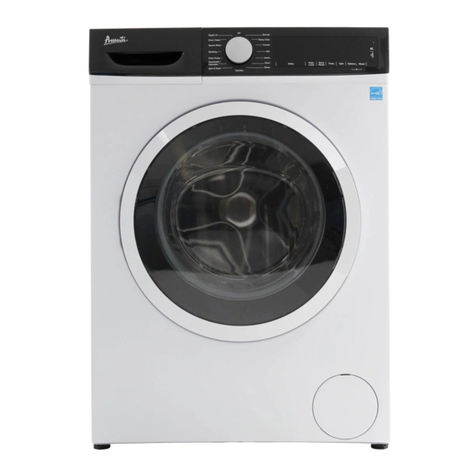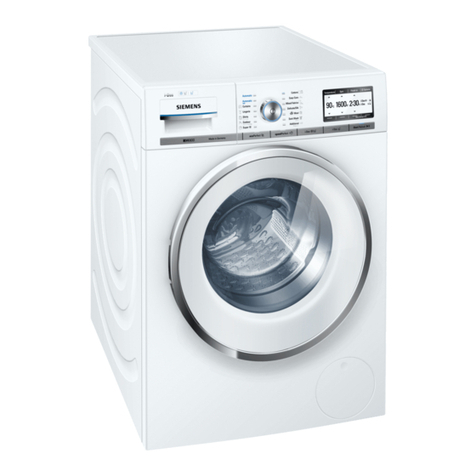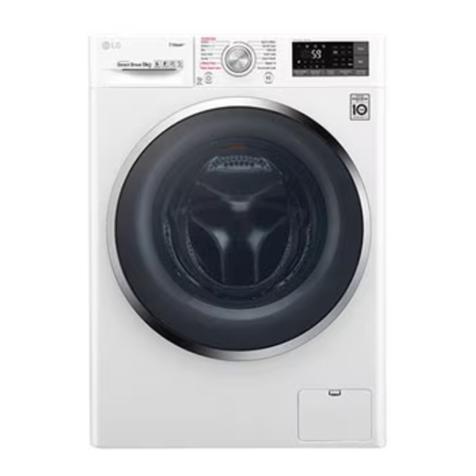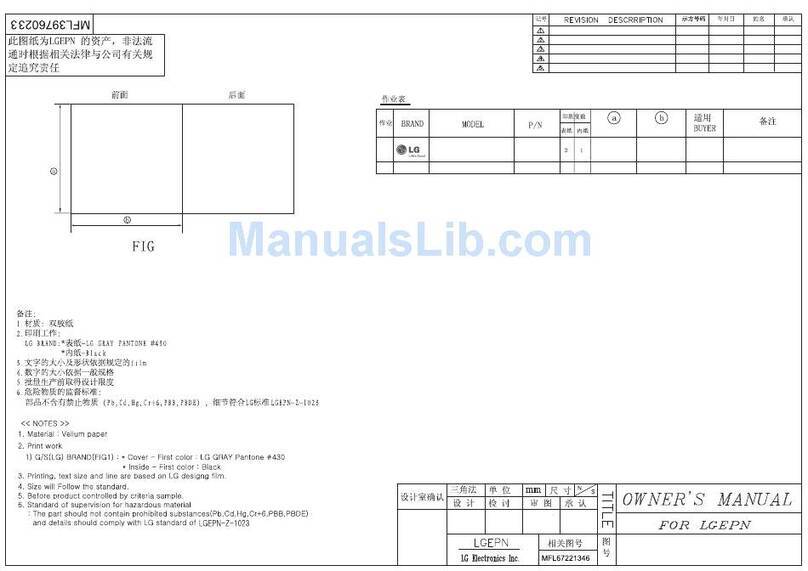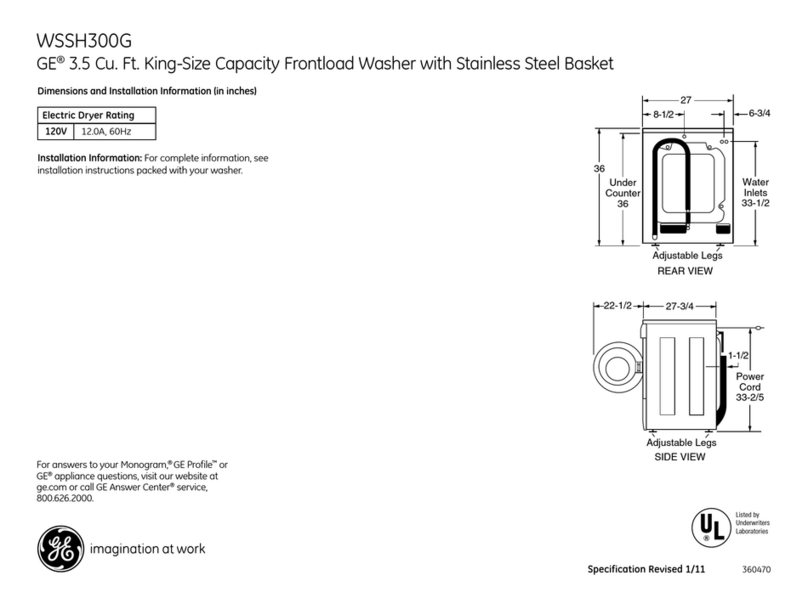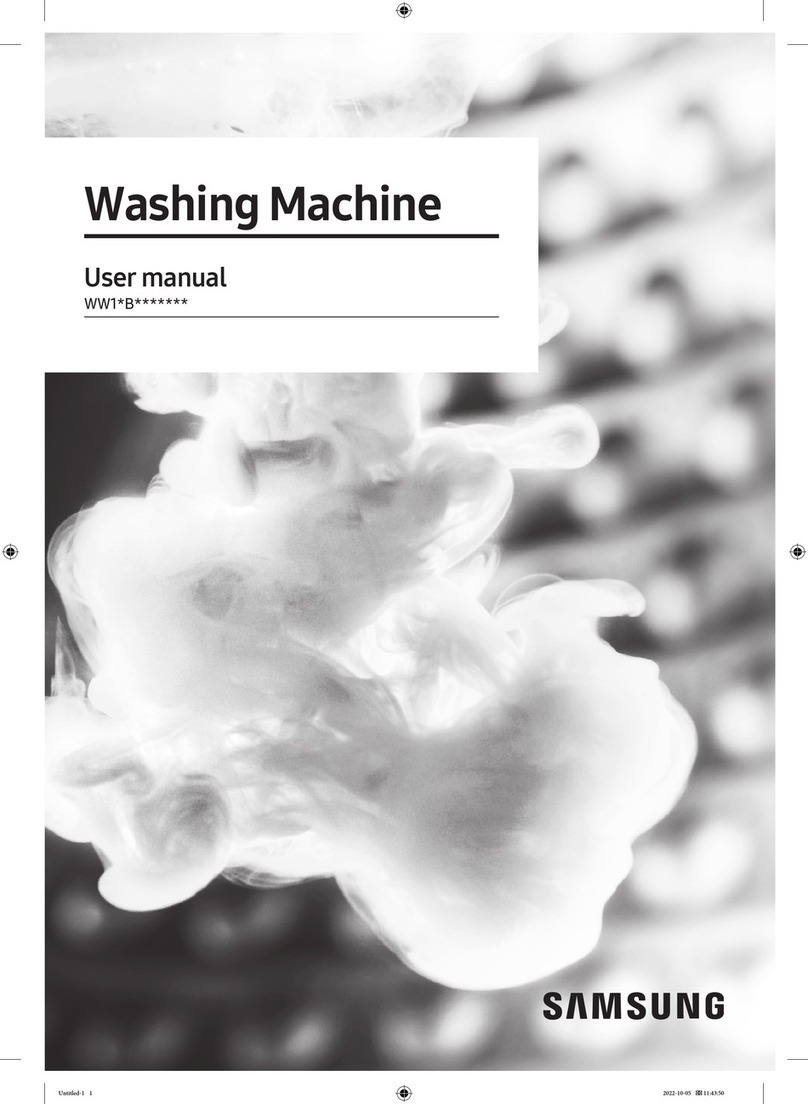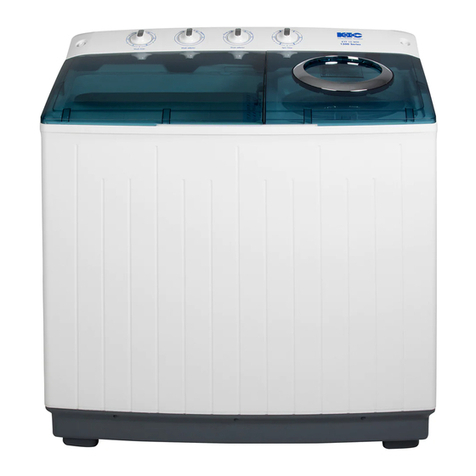Jenn-Air JW1000 User manual

WDDJENN-AIR
Use and Care Manual
Washer
Model JWIO00
-_.za_Jm]XIN-AIR _22
_MAPm F$$ o_ _--_L
WASH_N
FINEWA_
_LL TOSTARTPU_ _ STOP
Care of Special Items .......................................... 12-13
Care of Your Washer .................................................. 9
Congratulationsonyour choiceof aJenn-Air washer! As Energy Saving Tips ..................................................... 9
you use your new washer, we know you will appreciate Features ...................................................................... 8
the many features that provJde excellent cleaning re- Laundry Aids ........................................................ 10-11
suits,energy efficiency,convenience and dependability. Bleach ................................................................. 11
Detergents .......................................................... 10
Beforeyou beginwashing with your newwasher, please Fabric Softeners.................................................. 10
take a few minutes to readand becomefamiliar with the Presoak ............................................................... 10
instructions in this book.On thefollowing pages,you will Prewash .............................................................. 10
find a wealth of information regarding all aspectsof your Water Hardness .................................................. 11
beautiful new washer. By following these instructions Water Temperature ............................................. 11
carefully, you will be able to achieve excellent results. Operating the Washer Controls ...............................6-7
Cycle Description .................................................. 7
Should you have any questions about using your Jenn- To Set.................................................................... 6
Air washer, write to us. Be sure to provide the model Washing Guide ..................................................... 7
number. Preparing to Wash ...................................................... 4
Load Size .............................................................. 4
Jenn-Air Customer Assistance Precare.................................................................. 4
c/o MaytagCustomerService Sorting................................................................... 4
P.O. Box 2370 Problem Solving Guide ........................................ 17-20
Cleveland, TN 37320-2370 Safety Precautions...................................................2-3
Service Information................................................... 21
Stain Removal...................................................... 14-16
UsingYour New Washer ............................................ 5
Warranty ..............................................................23-24

d. Remove the door to the washing compartment
beforethe washer is removed from service or
discarded.
1. Read all instructions carefully before using the 5.
washer. Retain all instructions for future reference.
2. Installation - Installand locate this washer according a. Do not wash articles that have been previously
to the Installation Instructions. cleaned in, washed in, soakedin, orspotted with
gasoline, dry-cleaning solvents, other flammable
a. Thisappliancemustbeproperlygrounded. Never or explosive substances as they give off vapors
plugthe appliance electric cord into a receptacle that could ignite or explode. Any material on
which has not been grounded adequately and in whichyou haveusedacleaningsolvent, orwhich
accordance with local and national codes, issaturatedwithflammableliquidsorsolids,should
not be placed in the appliance until all traces of
b. This appliance must be connected to a properly theseflammable liquidsor solids and their fumes
rated, protected, and sized power supply circuit, have been removed. There are many highly
¢. Do not install or store this appliance where it will flammable items used in homes, such as: ac-
etone, denaturedalcohol,gasoline,kerosene,oil,
be exposed to temperatures below freezing or
exposed to the weather, chemical solvents, some liquid household clean-
ers, some spot removers, turpentine, waxes and
d. This appliance must be connected to adequate wax removers.
plumbing and drain facilities. b. Do not add gasoline, dry-cleaning solvents, or
e. This appliance should be installed by a qualified other flammable or explosive substances to the
service technician, wash water.
3.If someone should get an electric shock from thec. HYDROGEN GAS ISEXPLOSIVE. Under cer-
washer, disconnecttheelectricalpower. DONOT tainconditions,hydrogengasmaybeproducedin
OPERATE untilithasbeenrepairedbyanauthorized a hot water system that hasnot beenusedfor
Jenn-AirServiceContractor. 2weeksormore. Ifthehotwatersystemhasnot
been usedfor such a period,beforeusinga
4. To preventinjuryto children: washingmachine,turnon allhot waterfaucets
andlet the water flow from each for several
a. Do not allowchildrento playon, in, orwiththeminutes. Thiswillreleaseany accumulatedhy-
appliance.CIosesupervisionofchildrenisneces- drogen gas. Asthe gasis flammable, do not
sary whenusing the washer, smoke or use an open flame during this time.
b. Keep all laundryaids out of the reach of children d.Keep area around and underneath the washer
preferably in a locked cabinet.Use laundry aids free from the accumulation of combustible mate-
onlyas directedbythe manufacturer andobserve rials, such as lint, paper, rags, gasoline, and all
all warnings on the container labels, other flammable vapors and liquids.
c.Destroythecartonand plasticbagsafterunpack-
ing the washer. Cartons coveredwith rugs, bed-
spreads,or plastic sheets can create a chamber
with inadequate ventilation.

e. 11.Improperlaundering offlame retardantfinishescould
remove them. Therefore, follow garment manu-
facturer's instructions carefully.
12.Whenmoving,havethewashercheckedandproperly
installed by a qualified Jenn-Air Service Contractor.
SAVE THESE INSTRUCTIONS
6. Donot reachintotheapplianceifthetuboragitatoris
moving,Thewasherisequippedwithasafetyswitch
foryourprotection.IfactiondoesnotstopwhentheApplianceswiththe UL symbolon thedata platehave
washer lid is opened during the Spin Cycle,discon- been listedwith Underwriters' Laboratories,Inc. Those
nect the electrical power to the washer. Do not with a CSA Monogram on the data plate have been
certified by the CSA Testing Laboratories as complying
operate the washer until it has been repaired by an
authorized Jenn-Air ServiceContractor. withCanadianStandardsAssociationrequirements. Nev-
ertheless, as with any equipment using electricity and
7. Do not tamper with the controls, having moving parts,there are potential hazards. To use
this appliance safely, the operator should become famil-
8. Do not repairor replace any part ofthe appliance or iarwith theinstructionsfor operationoftheAppliance and
attempt any servicing to prevent personal injury and always exercise care while using it.
damage to the washer.
9. Observe these precautions when using cleaning
fluids,spot or stain removers,etc.:
a. Use only according to the manufacturer's direc-
tions as stated on the label or carton.
b.Use outdoorsor in a well ventilated area.
c. Use only products labeled "NON-FLAMMABLE".
d. After usingthese removers,thoroughly rinse the
clothes by hand before they are placed in the
washer. Some of these removers - for example:
rust remover - will damage the components and
the finish of the washer.
10. Do not wash fiberglass articles unless label states
they are machine washable.Mostfiberglass articles
shed small particlesof glass that will not readilyrinse
outofthewasher. These particlesmaygetonclothing
inlaterloadsand causeskin irritationand discomfort.
Be sure to rinsethe washer thoroughlybefore using
it again.
3

ISorting ] ILoadSize]
For best results,clothesshouldbe sortedinto loadsthatcan be• SizeofLoad -Thespacethatfabricsoccupyismoreimportant
washed and dried together. Sort clothesinto loadsthat can bethantheirweight.Forcleanwrinkle-freewashingresults,fillthe
washedwiththesamewatertemperature,washtime, agitation,spinwasher so that all items haveplentyofroomto movefreely.
Do not overcrowdthewasher. Thisis particularlyimportantfor
speed,and laundry aids. heavilysoiled items.
Thus, sort clothes according to: •Size of Items- Combine both large and small articles for good
• Color-Separate whites from colors, light colors from bright or washing action. Donotgroupall largeitems inone load. Several
dark colors. Wash non-colorfast items separately, sheetscembinedwithsmalleritemsinoneloadwillprovidebetter
washing action than a load of sheets only.
•Fabrics. Separateintocottons,delicatefabrics, andpermanent
press items.Cottonsrequire hotterwater. Delicatesrequire •How to Load- Looselyloadthewashertothetop ofthe small
shorter wash timesand cooler water to prevent shrinkage,vaneson theagitatorwithdry unfoldeditems.Do not:
Permanent press and syntheticsrequirespecial washing to
reducewrinkling, a. over packclothes;
•Lint Transfer - Separatelint-givers(terry cloth, chenilleand b. loadwet items(Thisencouragesoverloading.)
rugs)fromlinttakers(corduroy,syntheticknits,and permanent
press)to reducelinttransferduringwashing, c. wraplargeitemsaroundtheagitator.(Loadlarge itemsfirst
and in gentlefolds.)
•Amount of Soil- Separateheavilysoileditemsfrommoderately
andlightlysoileditems. Mixingsoiltypescouldcauseheavysoils
to depositon thelightlysoileditems.
lPrecareJ
Whenyou sort clothesintowashloads,inspecteach itemfor:
•Ripsand Tears - Mendall ripsand tearssothey don't grow.
•Objects Left in Pockets-Removecrayons,lipsticks,cigarettes,
ballpointpens, matches, tissues, and otherobjectsthat may
damageclothesand/orthewasher.
•Non-washable Items-Removebuttons,pins,buckles,or other
sharpitemsthat may notwashwell and that may scratchthe
insideofthewasheror snag otheritemsin theload.
•Dirt, Lint, and Sand -Turn downcuffsandbrushoffdirt andlint."
Vacuum rugstoremove loosesurface soil. Shakesandy clothes
and towels.
•Belts, Zippers, Hooks- Tie beltsand apron sashes into bows
so that they won't tangle during washing. Close zippers and
hooks sothat they won't snag other itemsin theload.Foradded
safety,placein mesh laundry bag.
•Spots and Stains - Remove before youwash the item. (See
Stain RemovalCharton pp. 14-16.)

1. Add Bleach, if needed, to the Bleach Dispenser 3. Place Clothes In Washer
Undilutedliquidchlorinebleachmay be added to the bleach Putdry,unfoldedclotheslooselyinthe tub,upto thetop ofthe
dispenser as shown,agitator vanesfora maximum load. Donotoverpack orwrapitems
around the agitator.
Carefullymeasurethe amountof bleachrecommendedon label of
the bleach bottle for the amount of water being used. Properly
diluted bleachwill be added automatically to thewash water.
Note: Place small or delicate items ina mesh bag.
Note: Oxygenbleachmaybeaddedbyfollewingtheinstructions
on thepackage. Donot putpowdered bleachor detergent
in the bleachdispenser. 4.Add FabricSoftener(ifoptionalfabricsofteneraccessoryis
in place).
Note: All bleaches,whether liquid or granular, are powerful Addrecommended amountto inner chamberof dispenser cup on
chemicals and can cause fabric damagesuch as tears or top of agitator. Do NOTadd above the fill line. If below the fill
color loss if notused properly, line, add waterto bring liquid level up to the fill line. Fabric soft-
ener will automatically be added to the final rinse.
For more information on Bleach, seep. 11. OPTIONAL LIQUID DISPENSER
2. Add Detergent _ ,,QU_D
Add measured amount to the washer basket before loading the _O'SPENSER
clothes. For more information on types of detergent and soap,
see p. 10.
The amount of detergent or soap to usedepends on how big the
load is, how ditty it is, and how hard the water is. Inadequate
amounts maycausepoor cleaning and other problems.
Note: Diluted fabric softener can beadded to the rinse water.

ITo set: }
1. Set TEMP. SELECTION (Wash& RinseTemperature)3.Select Cycle and Time
Four different water combinations are provided. To set Cycle andTime, pushtheTIMER DIALin (offposition) and
Wash Rinseturn it to the right (clockwise) until the red indicator is at the
recommended starting point in the wash segment in either the
Hot Wash Cold RinseREGULAR WASH,FINE WASH,or PERMA PRESS WASH
Warm Wash Warm Rinse cycle, See CycleDescriptionsonp. 7.
Warm Wash ColdRinse
ColdWash ColdRinse 4. Pug TIMER DIAL Out To Start Washer
These temperatureselectionsare to be used with"REGULAR YoumaystopthewasheratanytimebysimplypushingtheTIMER
WASH, FINE WASH, or PERMA PRESS WASH.DIAL in. Thereforeitis possibleto obtaina non-agitatedsoak for
aslongas you wish, or to shorten,skip or repeatany part of a
For moreinformation on water temperature, see page 11. cycle. TheTIMERDIAL mustbe pushedin (off position)whenyou
change thesetting.
2. Set WATER LEVEL Note: Do notattempttoturnthe TIMER DIAL counterclockwise
Determinetheselectedsettingbasedon clothesloadsize(seesincedamageto thetimerwillresult.
table). Besureto se/ectenoughwater to permit clothesto
circulate during agitation. 5. Stops automatically when wash cycle is completed.
Water Level Dry Weight of Clothes 6.Turn off faucets when not using washer. This is toprotectthe
Control Setting (pounds) (kilograms) waterfill hoseagainstexcessivepressure.
Super 12+ 5.4+
High 6-122.7 - 5.4
Medium2-6 .9 - 2.7
Low 2 or under .9
/tmay become necessary,duetobulkyfabrics,toadjustthewater
levelafter agitation begins. Toadjustfor a higherwater level, slide
control tothe RESETpositionandthen backtothedesiredsetting.
Note: When laundering permanent press garments or garments
of delicate construction, washablewoolens or loosely knit
articles, never useless than theHIGH WATER LEVEL
setting. This willminimizeshrinkage,wrinklingandpulling
ofseams.

REGULAR WASH PERMA PRESS
REGULAR WASH provides REGULAR agitation and FAST spin PERMA PRESS provides REGULAR agitation speed with SLOW
speeds for regular wash cycles to wash cottonsand heavily soiledspinspeedfor permanent press fabrics.
fabrics.
FINE WASH
FINE WASH providesGENTLE agitation speedand SLOW spin
speed fordelicates and double knit fabrics.
Washing Guide
AUTOMATIC TEMPERATURE
CYCLE & SPEEDS SELECTION
Wash Load TIMER DIAL AGITATION Speed* SPIN Speed Wash Rinse
Cotton and Linen,REGULAR REGULAR FAST HOT COLD
White, Colorfast WASH
Cottonand Linen, REGULAR REGULAR FAST WARM COLD
Non-Colorfast WASH
ColdWater Wash REGULAR REGULAR FASTCOLD COLD
WASH
Permanent PressPERMA PRESS REGULARSLOW ROT COLD
Whiteand Colorfast
Permanent PressPERMA PRESS REGULAR SLOW WARM COLD
Non-Colorfast
DoubleKnits and FINE WASH GENTLE SLOW WARM COLD
Delicates
*NOTE: The agitation and spin speeds areautomaticallyset based onthecycleselected.
7

ILint Filming system (Automa'dc)]
The Lint Filtering system does not require cleaning. A built-inprotector automatically shuts off the washer motor incase
ofanoverload. This canoccurif:
Washandrinsewaterisfilteredandre-filteredcontinuouslytotraplint
shed by most fabricsduring agitationcycle before it can bere- • Too heavya loadisbeing washed.
depositedonthewashload.The engineeredholedesignonthewash
basketinconjunctionwithwaterflowprodueedbytheagitatortrapslint •Too many appliances areplugged into thelineoperating
away fromthe clothesbetweentheinnerwashbasketandoutertub. yourwasher.
Lintisautomaticallyflushedfromthewasherduringspin cycle.• A lowvoltageconditionexistson theline.
•Lidisopenedandclosedrepeatedly.
Theoverloadprotectorpermitsthewasherto startagainwhen the
Your washer is designedto handleout ofbalanceloadswithout motorhascooledto a safe operatingtemperature.
shuttingdownorinterruptingthewashingcycle.Thecyclewillalways
becompleted,butclothesinthiscyclemaycontainexcessivemois- Ifthemotorstopsrepeatedly,callyourJenn-AirServiceContractor.
ture. RedistributetheclothesinthewasherandresettheCydeControl
forthefinalspinperiod.
If for any reason you open the washerlidwhenthe washer isin a
SPIN period,theoperation willimmediately stop. IFYOUR WASHER
DOES NOT STOP, CALL YOUR JENN-AIR SERVICE CONTRAC-
TOR IMMEDIATELY.
Whenthelidis closed, the operationwill automaticallybe resumed.
8

1. Usewarmor coldwater towash lightly soileditems; usehotwater 5. If proper sorting produces small loads, adjust the water level to
for loadsthat contain white items and loads thatcontain heavily the size ofthe load. (Use enough water soclothes move freely.)
soiled items. 6. Donot over load the washer. Overloading reduces the cleaning
2. Select a wash time and cycle according to the degree of soil. action ofa washer and resultsin more abrasion,lintand wrinkles.
Shorter wash times can be usedfor lightly soiled items. Infact, too large a load canwaste energy and can require you to
wash the load again.
3. Save clothes of similar color and similar degree of soil untilyou
have a full load. An automatic washer goes through the same 7. Use the FAST Spin for highly absorbent items such as towels,
cyclefora fullload orsingle pair ofjeans. Themoreyouplanyour blankets, etc.This methodremovesmorewaterand helpsreduce
wash for full loads, the moreelectricity and water you save.drying time.
4. Useacoldwaterrinse. Inmostinstancesacoldwaterrinseisjust 8. Useyourwasherduringnonpeaktimesasreeommendedbyyour
as effective asawarm one. local utilitycompany. Thisdoes notsave youenergy buthelpsto
free electrical power during peak periods.
1. After washing leave the lid open until the interior is dry. 8. Remove pins,buckles or other sharp objects from clothes to
prevent scratching theinteriorparts.
2. Check hoses to be sure there are no kinks or knots. 9. Clothes should not be storedin washer.
3. Your washershould notbe installed orstored where temperature
will go belowfreezing, as damage to the washer could result. 10, Bleach, detergent,solvents,etc. spilledonthe topofyour washer
that areallowed to remainwill removethe glossy finish. Remove
4. Occasionally wipe exterior with a clean damp sponge or cloth, all spills with a damp,soft cloth. Care should also be exercised
Polish with a soft dry cloth. Do not use abrasivecleansers, when using a prespotting agent since it may damage printing or
control panelfinishes.
5. Lifetime lubrication isdoneat the factory, so your washer never
needs to beoiledor greased. 11. Ifyoucloseyourhomefor thewinter,havea servioemandrainthe
washer. Unplug cord from theelectric outlet and disconnect
6, Donot lay heavyorsharp objectson topof yourwasher, hoses fromfaucets.
7. Thetopofthewashershoutdnotbeusedforremovingstainsfrom
garments. Some stain removers, such as rust remover,will mar
thefinish.

IDetergents I
Detergents come in many types and forms. Regardless of the type Fabricsofteners are designed to reduce staticelectricity,make
itis important to read the manufacturer's instructions andusethefabricssofferand fluffier, and minimizewrinkling. Thethreetypesare:
correct amount. The proper amount to use depends on several rinse-added, dryer-added, and detergents with fabric softeners.
factors:
a. size of load; Rinse -Added Fabric Softener
b. degree of soil; These softeners should only be used in the final rinse cycle. They
¢. hardness of the water; and should not be used with soap, detergent,bleach, water conditioners
d. amount ofwater, or other laundryproductsin therinsewater. If usedtogether, they will
react andcause.a white sticky residue to appear on clothes. This is
Most manufacturer's instructions are for washing an average load sometimes mistaken for lint.
with average soil in 16 gallons of water with average hardness
(5 grainsper gallon). Therefore, moredetergent will be needed ifany It is important'that you dilute fabric softeners with water before you
of thefollowing exists; pourthemintotherinse water.This willhelp eliminatethe possibility
a. load size is extra large, of staining any fabrics.
b. clothes are heavily soiled,
c. water hardness is above average, or Dryer- Added
d.amount ofwaterselected was morethanHIGH. Thi§type offabric softener isadded tothe dryer along with the loadof
clothes. It maybe intheform of a softener impregnatedtear-off sheet
Usingtoo little detergent results in a poorwash, while usingtoo much or a slow dispensing packet.
causesoversudsing.
Non-phosphate Note: Avoidoveruseof fabricsofteners. Toomuch fabricsoftenercan
make clothes, such as diapers and towels, non-absorbent. If
As phosphatecontent is controlled by law in some areas, most this occurs, decrease theamount of fabric softener used or
detergents are non-phosphate.Some granular non-phosphatedeter- occasionally omit using it. If fabricsoftener comes in contact
gents may be difficult to dissolve in cold water. They may also react withfabrics, itmay causeastain.To remove,wet fabricand rub
with thehardness minerals inthe water to deposit a white"lint like" thestained area with a bar of soap and wash items again.
residueonclothes as well as washer parts.
For best results with non-phosphate detergents follow these Detergentwith FabricSoftener
suggestions: Some detergents contain fabric softener in their formulation. Read
1. Wash garments in the hottest watersafefor the fabric, and follow manufacturer's instructions for use.
2. Pretreatstains and heavily soileditems beforeplacing them in the
washer.
3. Follow thedetergent package instructions for the amount to use.
4. Add the detergent to the washer first, then add the load of clothes
to bewashed. Close the lid and fill the washer with water. Presoakproducts help to breakdowncertaintypes ofsoils and stains
5. Insome instances, soft or softened water may help.into simple forms which can be removed moreeasily by the other
detergent ingredients and the washing action. Washing products
Liquid or Powder Detergent containingenzymeeareeffectiveonprotein-typestainssuchasblood,
Powdereddetergentsgenerally providegood resultsfor most laundry baby formula, milk, meat juice, diaper soil, grass, etc. Enzyme pre-
loads. Liquiddetergentsare particularlyusefulforcoldwaterwashing, soak products aremost effective when they havetime in which to
for washing lightly soiled loads and for pretreating spots or greasy work. Clothes should soak for at least 30 minutes and it is helpful
soils,sometimes to soakclothesfor several hours.
High suds or low suds?
Mounds ofsuds are notnecessary for clean clothes. Too many suds
can hamperwash action. Thepresence ofsuds does notindicate the
correct amount of detergent being used.In very soft water a low
sudsing detergent maybenecessaryinorder touseenoughdetergent Prewash spray productsare helpful in removing collar soil, and other
stains. Follow package directions.Usecaution when usingprewash
to clean clothes, spraysbecausetheycan remove markings fromdials and buttons on
appliances, paint from wallsand cabinets, or soften fingernail polish.
Soap should not beusedunless yourwater is very soft (0 - 3grains
of hardness per gallon).Inhard water (above 3 gpg) soap combines
with water hardnessmineralsto form a scum of film. This deposit ks
very hard to rinse out and canbuild up on clothes causing them to
become gray, dingy and greasy feeling.
10

IDisinfeCtants t
Occasionally,you may want to sanitizeyour washer and laundry.Many complaints about unsatisfactory washing resultscan be traced
Sanitizing is desirable during periods offamily illness to help prevent directly to hard water. Water hardness is measured in grains per
thespread of infections from one family member to another, gallon.
To Sanitize Your Washer Hardness Grains Per Gal.
Fillwasherwithhotwater,pour1-1/4c.ofliquidchlorinebleachintotheSoft 0 - 3 grains
bleachdispenserordirectlyintothewasher.TurnTIMER DIALto 12Medium 4 - 6 grains
minutes;closelidor door,andstartwasher.Letwashercompletethe Hard 7-10 grains
cycle. Very Hard over11 grains
Sanitize Your Laundry Thelocalwater company or County Extensionofficecan supply
Selectadisinfectantthatsuitstheloadoflaundry(fiberandcolor),and informationaboutwaterhardnessinyourarea.
carefullyreadthedirectionsonthepackage.Followthemanufacturer's
directions for amount to use, and note any precautions.CarefullyIdeally,softwatershouldbeusedbothforwashingand rinsing. Ifyour
measure therecommendedamount of disinfectant,and add itdirectly water is hard, itcan be softened in several ways:
to thetub attheproper time in thecycle. Do notput any disinfectant
otherthan liquidchlorine bleachintothedispenseras itcoulddamage 1. Increasingtheamount ofdetergent isan effectiveway totie upthe
the dispenser,water hardness minerals.
2. Add a non-precipitating water conditioner to the wash and rinse
IBleach iI water.
Bleach helps to whiten clothes, remove certain stains and soil, 3. Consider installing in your homea mechanical water softener
disinfect and deodorize. Bleach should be used in the wash cycle, which will soften the water as itflows through the faucet.
The two basic types of bleach are: Chlorine-Liquid and Oxygen-
Type-Dry.
Chlorine-Liquid
Chlorinebleach can be usedwhen washing mostfabrics. Donotuse The correct water temperature insures good washing results. Select
chlorine-bleachwithacetate,rayon,silk,wool,Spandex,or noncolorfast the water temperatureaccording to the fabrics being washed and the
fabrics.When in doubt, check garment manufacturer's care label, degree of soil present.
Always follow the bleach manufacturer's directions for the amount to HOT
use. Usuallyitisbesttoaddbleachtothedispenserbeforeloadingthe HOT water is effective for washing most white items or for washing
washer in order to prevent any undiluted bleach from accidentally heavily soiled colorfast items. It isalso helpful in removing bodysoil,
spilling onto items in thewash load. perspiration and greasy soils. If your water heater is located a great
distance from the washer, it may be necessary for you to set the
Fabric damage relatedto misuseof chlorinebleach may not appear thermostat on the water heater to its hottest setting because water
until several launderings later. If undiluted bleachcomes into direct cools as it travels fromthe water heaterto the washer.
contact with fabrics, it will show up as rips, tears, holes,overall
yellowingor color loss. WARM
I' WARN NG--Do NOT usebleaChWith :_ =i I WARM water is recommended for washing normal to lightly soiledamm°" a_.l'regular,permanent press,knit and some delicate items. It reduces
the amount of fading and the amount of wrinkles.
Oxygen-Type-Dry
Oxygen type bleaches are mild,contain no chlorine, and are consid- COLD
ered safe for most washablecolorfast fabrics. They may beadded COLD water minimizes shrinkageand gives best color retention.
directly tothe washwater along with the detergent. Followdirections Using coldwatercan provideless effectivecleaning,so besureto use
on the packagefor the correct amount to use. Oxygen bleaches area detergent especiallyformulated for cold water. Sincethetempera-
more effective in hot water. They are not designed for heavy stain tureofcoldwatervarieswiththeseasons, someitems may notlookas
removal, clean as in warmer water.Follow these steps for best results when
usingcold water:
• Increase amount of detergent to about 1-1/2 times amount
normally used.
• Dissolvedetergent in warm water beforeadding to the washer.
• Pretreat spots and stains.
• Increasethe length of washing timeto maximum provided.
11

Item Description of Care
BEDSPREADS Choose HOT or WARM water temperature according to colorfastness and amountof soil. Set
(Chenille, Fiberglass, Beta R, Quilted) waterlevelat SUPER.Wash separatelyfor 10 minutesat REGULAR speed. UseCOLDrinse.
Most fiberglass materials should not be laundered in your washer.Check label to be sure
spread is machine washable. If it is, wash separately at SUPER water level. Check label for
correct water temperature.If none available, use WARM WASH/COLDRINSE. Agitate for
4 minutes at GENTLE speed.
BLANKETS
Man-made fabrics: Acrylic, nylon, etc. Somenapped blankets madefrom man-madefibers tend to pill. Check labelto seethat blanket
has an anti-pilling finish. Be sure to follow any directions that come with the blankets.Avoid
excess agitation. This method may be usedforelectric blankets and sheets (if labeledmachine
washable).Wash separately using WARM or COLDwash and rinse.If heavily soiled, soak,
otherwise wash 4 minutes using GENTLEwash with NORMAL spin speeds.
Woolen (Washable) Measure blanket and pretreat heavily soiled areas. SetTIMER DIAL for maximum wash time.
UseSUPER water level,WARMwash,GENTLEagitation and FASTspin. Adddetergent. Start
washer and agitateforone minutetodissolvedetergent. Stopwasher. Add blanket and immerse
completely in water. Close lid and soak (without agitation) 10 to 15 minutes,depending on
amount ofsoil. Agitate 1-2minutes. AdvanceTIMER DIALtoend ofwashcycle toremovewater
from basket. Allow washer to fill with WARM rinse water.Stop washer and soak for
5 minutes without agitation.Advance TIMER DIAL to SPIN. Spin one minute. Repeat rinse
agitation 1-2 minutes and allow washer to complete SPIN cycle.
Layblanketon flat surface, and ifnecessary,block bygently stretching tooriginal measurement.
Woolen blanketstendto shrinkmorethefirsttimethey arewashed becauseofthecharacteristics
of wool fibers.Look for shrinkage controls on label.
CURTAINS/DRAPERIES Checklabeldirectionsbeforewashing. Besurefabric iswashable, shrink resistantand colorfast.
DO NOT wash lined draperies or fiberglass curtains.Wash curtains frequently as heat, light
and sun weaken fibers. Eventhough sunspots may not be visible, they could cause holes to
appear after laundering.
Removehooks, pins and trimmings. Shake to removelint and dust. If heavily soiled,soak or
prewash inwarm water. Place loosely woven or delicate fabrics in a mesh laundry bag. Wash
in small loads using ample water because crowding will cause wrinkles. Wash no more than
2 or 3 pairs of curtains; 1 long pair or 2 short pairs of draperies.
Use ROT washfor colorfast cottons andWARM wash for rayon,non-colorfast cotton,polyester,
nylon or permanent press fabrics. Use COLD rinse. Soak 5 to 10 minutesfollowed by 2-6
minutes of GENTLE agitation. Use SLOWspin.
DIAPERS Rinse in COLD water immediatelyafter use.Soak in covered pailof clean warm water with
detergent.Beforewashing,spinexcesswaterfromdiapers. LaunderinHOT water,detergent
andbleach.Agitatefor 12-14 minutes. Wash upto5 dozendiapers. UseREGULAR speed.
ELASTICGARMENTS Elasticgarmentspickupbodyoilsreadily.Becausetheseoilsaredamaging,elasticsshouldbe
washed frequentlyto prolongthelifeofthegarment.
Pretreat any soiledspots. To avoid snagging, closezippers, fasten hooksandgarters.
Dependingon amountof soil,use eithera HOT orWARM washsetfor GENTLE speed and
wash4-6 minutes.
FIBERGLASS Read manufacturer's instructions.
OnlyFiberglassBetaRfabricsmay belaunderedasindicated. Neverusebleach.Donotwash
fiberglassfabricsinyourwasherbecausethefiberscanbreakandremaininthewasher. These
glass particlescouldbecomeimbedded inthefabricswashedinthenextloadand causeskin
irritation.Wash afull loadofitemsusingWARM washandCOLD rinse. Agitate2-3 minutesat
GENTLE speed.
12

Care of Special Items (Cont.)
Item Description of Care
FLAME RETARDANT FINISHES To helpreducethe possiblelossofthe flame retardantfinishthroughcontinuouswashing,clean
accordingtotheinstructionsfurnishedby themanufactureroftheitem.
LINGERIE,DELICATE BLOUSES UseHOTwaterforwhitecotton,permanentpressorblends. UseWARMwaterforsilks,rayons,
acetatesandcolors.Ifdesired,placeverydelicatelyconstructedgarmentsina meshbag. Wash
4 to 10 minutes. FollowwithCOLD rinse. REGULAR speed for sturdy items andGENTLE
speedfordelicateitems.Checkhangtag.
PLASTICS Checkcurtainstobesuretheyarenotrippedortorn. Wash showercurtainswithoutdetergent,
(ShowerCurtains,Tablecloths, usingpackaged non-precipitatingwater conditionerto avoidwater spotswhen dry. Soak,then
Baby Panties, Rubber Boots) agitate nomorethan2 minutes. (Usuallyshower curtainsare coveredwith sudsysplashes, thus
adding detergenttowash isnot necessary.) Whenwashing, useWARM WASH/WARM RINSE
and GENTLEspeed. Line dry.
PILLOWS Donot wash pillowsfilledwith kapok,fiberglass or cotton. Check labelson fiber-filledpillows
to makesurethey aremachinewashable. Check tosee thatallseams andfabricsarestrong
andwillnotbreak. Ifindoubt,placeinzipperedcase or inpillowcaseand basteshut. Keep
outercoveringon foampillowsor placein zipperedcase. Wash pillowstwo at a timeto
balanceload.Placepillowsin thewasheron oppositesidesoftheagitator. UseSUPER fill.
After washer fills,press pillowsintowater to removeair. Wash withWARM water and
detergent.Stopwasherafter2minutes,turnpillowsover.Wash for a totalof 4 to8 minutes.
Rinse. UseREGULAR WASH or FINE WASH and REGULAR spin.
RUGS (Scatter) Check label tomake surerug iswashableand colorfast. Vacuumor shaketo removeloose
surfacesoil. Soakor prewash rugifit is badly soiled. Useamplewaterasrugs arevery
absorbent. Exampleofaload: One4' X 6' orthree 2'or3'. Washmorethanonesmall rugat
atime. Ifyouwashonlyonesmallrug,add bathtowelstobalancetheload.Alargerugshould
bedistributedevenlyaroundtheagitatortobalancetheload. Besuretherugcan movefreely
duringagitation.Use HOTwaterforwhite,cottonrugs. Use WARMwaterforcolorsandrubber
or Latex-backedrugs. Wash 8 to 12 minutesat REGULAR speed.
SLIPCOVERS Besurefabriciswashable,shrink-rasistantandcolorfast. Shakeorvacuumtoremovelintand
dust.Closefasteners. Pratreatanyheavilysoiledspots.Washinsmallloadsusingamplewater,
as theseitems areoften bulkyand absorba largeamount. Soak or prewash if heavilysoiled.
Use WARM wash with a COLD rinse. Soak 5 to 10 minutes, then wash 6-8 minutes. Use
REGULAR speed unless slipcovers are weakened by age, then use GENTLEspeed.
SWEATERS(Man-Made) Follow manufacturer's instructions. Treat as a delicate item.
Follow procedures used for woolen blankets. Check label to be sure it is machine washable.
Handmade knits should NOT be dryer dried.
WATER REPELLENT FINISHES Waterrepellentfinishesareapplied tosuchfabricsorfinished itemsassportjackets, all-weather
coatsandsleepingbagstoprovideprotectionfromrainordampness.Thesefinishesalsomay
resiststains.To maintainwaterrepellentproperties,itisimportanttorinseitemsverythoroughly
during[aundering.Usingafabricsoftener,thenpressingthegarmentthoroughlyhelpsmaintain
thewaterrepellentproperties.
13

I Tips 1
• Treat stains promptly• For unknown stains, follow these steps in sequence until thestain is
removed•
• Identify the stain,if possible. 1. Soak the stain in coldwater for at least 20 minutes•
• Avoid using hot water on unidentified stains, as it might set the
stain• 2. Work a liquid laundry detergent into the stain area and allow to
stand for 30 minutes, then rinse•
• Never iron a stain as this will set it.Beforeyou use any stain
remover, be sure it will not harm the fabric, finish, or color• The 3. Launder in hottest water safe for fabric using ample amount of
watertemperature, typeofstain remover,orbleach, andeventhe laundry detergent• Use a chlorine bleachon white or colorfast
methods, may vary depending upon the fabric or color• cottons. Nylons, acrylics, polyesters, rayons or other fabrics use
an oxygen bleachand warmwater• Setwasher for10 minutesand
• Always test stain remover on an inconspicuous area (a seam allowthewasherto gothrougha completecycle. Soaksilkorwool
allowance, hem, orfacing) to be sure itwill not harmthe fabric, articles in warm water and agitate very briefly, if at all.
•Place stainedareaface down on paper towels and applystain4. Soak overnightusing a laundry presoak product, following
remover to underside of stain• This will force the stain off the manufacturer's directions•
surfaceand notthroughthe fabric. Replacetowels frequently to
prevent stain transfer• 5. Sponge the stainedarea thoroughlywith dry cleaning fluid.
Repeat, if necessary. Rinsethoroughly by hand and launder•
• Somestainsare difficultto remove. It maybe necessaryto repeat
a procedureseveral times before a stain is removed•
• To avoid personalinjury,0bserve,_llp_c&_ibllS_v_ehon Me- use prewash sprayswith caution as they can remove markings from
product|abets of stain rem0ver_ that _eflaming, _giveoff dials and buttons on washers and dryers, paint from walls and
poisonous vapors, or that arepo_orl_sif s_alloWbd.,cabinets,and softenfingernail polish•Whenyouarewearingfingernail
," ' polish, be sure it doesn't rub off on the itemsyou are pretreating.
Excessively soiled articles,suchas men's work clothes,diapers,or
items in the dryer, children's play clothes, need to be prewashed in warm water and
detergent to help loosen soil• Follow with a REGULARWASH to
which detergent has been added•
Soakinghelpsloosensoil. Soakinwarm orcoldwater with an enzyme
presoak orlaundrydetergent• Letlaundryproduct dissolvethoroughly
before adding clothes•
Toprevent transfer ofdye, soak white fabrics separatelyfrom colored
ones.Soaking items for at least 30 minutes is recommended but
sometimesitisnecessarytosoakfabrics forseveral hours(particularly
those stains that have been in the fabric a long time).
14

This chart appliesonlytowashable items. Itdoes notapply toitemswhich should bedrycleaned. Always treat stainsas soonas possible before
laundering. Air dry articles to be certain stain hasbeen removed; machine drying could make the stainmore difficult to remove. You can use
prewash spray products oryou can rub detergent into the dampened stain.
Stain Removal Procedure
Alcoholic Beverages/Wine Sponge promptlywith coldwater or soak in coldwater30 minuteswith detergent. Pretreatremaining
stain. Launder with an appropriate bleach.Use the hottest water safe for the fabric.
Blood Rinse or soak incold waterwith detergent for 30minutes.Pretreatremaining stain.Launder in th_
hottestwatersafe forthe fabric. Useappropriate bleach. Ifstain stillpersists, soakinwarmwaterwith
a presoak product.
Candle Wax Scrapeoff excess witha dullknife. Place stain between severallayers ofclean white paper towels,
and press with a warm iron.Sponge with cleaningfluid. Rinse. Ifstain remains, launder in the hottest
water safefor the fabric and using appropriate bleach.
Carbon Paper Rubdetergent intodampened stain. Rinse thoroughly. If stain persists,put afew dropsof ammonia
on the stain and repeat treatment with detergent. Rinse thoroughly. If necessary, repeat. If
colorfastness is in question, usehydrogen peroxide instead of ammonia.
Catsup Scrapeoffexcesswithdullknife. Soakincoldwaterfor30minuteswith detergent. Pretreat remaining
stain. Launder with an appropriate bleach. Usethe hottest water safe for the fabric.
Chewing Gum Rubwithicetoharden. Scrapeoff excess witha dullknife. Spongewith cleaningfluid.Rinse byhand
and launder using the hottest water safe forthefabric.
Chocolate,Cocoa, Coffee or Tea Rinse orsoak incold water with detergent. Pretreat remainingstain. Launder usingthe hottest water
safe for thefabric. Useappropriate bleach. If stainremains,spongewith asafe cleaningfluid. Rinse
by hand. Launder again.
Cosmetics Pretreatthestain. Launderusing the hottest water safe for the fabric.Use appropriate bleach.
Crayon Rubdetergentorsoap into dampenedstain untilathick suds isformed. Work in untiloutline ofstain
isremoved. Launderin hotwaterusingchlorinebleach,ifsafeforfabric. Repeat process,ifnecessary.
Forstains throughout a load of clothes, wash items in hot water using laundry soap (notdetergent)
andonecupofbakingsoda. Ifcolor stain remains,launderwith adetergent aedchlorine bleach. Use
warm waterand oxygen-type bleach insteadof chlorine bleach if colorfastness is in question.
Deodorants andAnti-PerspirantsPretreat the stain. Launder using the hottest water safe for the fabric. Use appropriate bleach.
Anti-perspirantsthat containacidic substances,such asaluminumchloride, maycause fabricdamage
and changethe color of somedyes. Color might be restored by sponging with ammonia.Rinse
thoroughly. If colorfastness is in question,launder in warm water.If ammonia treatment is required
totreat wool, mohair or silk, dilute with equal amount of water. Rinse thoroughly.
Egg,MeatJuice and Gravy If dried,scrape offas muchas possiblewith a dullknife. Soak incoldwaterwith detergent. Pretreat
thestain. Launderusingthehottestwatersafeforthefabric. Useappropriatebleach.
Fruit, Fruit Juice Soakincoldwaterwithdetergent.Pretreatthestain. Launderusingthehottestwater safeforthe
fabric. Useappropriatebleach.
Glue Soakinwarm waterwithdetergent. Launderinhotwaterif fabriciscolorfast.
Grass Pretreatstain.Launderusingthehottestwatersafeforthefabric. Useappropriatebleach.Ifstain
remains,spongewithdenaturedalcohol.Rinsethoroughly.Ifcolorfastnessisquestionableorfabric
isacetate,dilutealcoholwithtwoparts water.
Grease, Oil and Salad Dressing Pretreatstain. Launderusingthe hottestwatersafe forthefabric. Useappropriatebleach.Ifstain
remains,spongewithcleaningfluid. Rinsethoroughlybyhand.Launderagain.
15

Stain Removal Chart (Cont.)
Stain Removal Procedure
Ink (Ballpoint) Spraystain with hairspray until saturated orsponge stain with rubbing alcoholor spray withpretreat
product. Rinse thoroughly. Pretreat stain. Launder using thehottest water safefor the fabric. Use
appropriate bleach.
Ink (Felt Tip) Spraystain with liquid household cleaner untilsaturated. Rubcleaner intostain. Rinse. Repeat as
many times as necessary to remove stain. Launder.
Mildew Pretreat stain. Launder usingthe hottest water safe for the fabric. Use appropriate bleach. If stain
remains, spongewith hydrogen peroxide.Rinse thoroughly and launder again.
Milk, Cream, Ice Cream Soak incold waterwithdetergent. Pretreatstain.Launder usingthe hottest water safe for thefabric.
Useappropriate bleach. Ifgreasystain remains,spongewith cleaningfluid. Rinse byhand.Launder
again.
Mud Letstain dry,then brushwell.Sponge withcold water.Pretreat stain. Launderusingthe hottestwater
safe for the fabric. Use appropriate bleach.
Mustard Pretreat stain. Launder usingthe hottest water safe for the fabric.Use appropriate bleach.
Nail Polish Place stain facedown on paper towels. Sponge with nail polish remover or amyl acetate. Useamyl
acetate only on acetate. (Test nail polish remover on seam of garment first.) Launder after rinsing
thoroughly by hand. If color remains,bleach,if safe for fabric.
PerfumeSponge promptlywith coldwater or soak incold water 30 minuteswith detergent. Pretreat remaining
stain. Launder with an appropriate bleach.Use the hottest water safe for thefabric.
Perspiration Pretreatremainingstain.Launderwithan appropriatebleach. Usethehottestwater safeforthefabric.
If fabric has been discolored,restore by applying ammonia to fresh stains or vinegar to old stains.
Rinse. Launder.
Rust Apply rustremover according to manufacturer's directions.Launder.Do notusechlorine bleach on
rust stains.Donot use rust remover in washer or on washertop.
ShoePolish Scrapeoffas muchaspossiblewith adull knife.Pretreat remainingstain.Launderwith anappropriate
bleach. Use the hottest water safe for thefabric. If stain persists,sponge with one partdenatured
alcohol and two parts water. Rinse thoroughly by hand. Launder.
Tar Treat immediately beforestain is dry. Pour cleaning fluid through fabric.Repeat.Stain may be
_mpossibleto remove. Rinse thoroughly by hand. Launder.
UrineSoakinooldwaterwithdetergent,Pretreatremainingstain.Launderwithanappropriatebleach. Use
the hottest water safe for the fabric.
16

Problem Remedy Prevention
C_hesLint on
Are clothes sorted properly? Areyou using Brushlintfrom clothesor usea lint removerSeparatelint-giver(terrytowels, sweat-shirts,
enough detergent,overloadingwasher, leav- roller, chenille) from lint-receivers (corduroy, per-
ing tissue paper inpockets, or overdrying? manent press,knits). UseGENTLEagitation.
Man-made fabrics, blends and permanent
press readily attract lint from cottons due to
static electricity. Use a fabric softener in the
dryer to lessen static electricity. Increase
detergent. Empty pockets.
Gr_ orOily
Foodorcooking oil stainson syntheticfabrics Rub in undiluteddetergent, letstand 30 min- Wash synthetic garmentsassoonafter wear-
are sometimes called "invisible stains" be- utes and rewash,using hottestwater safe for ing as practical, using moredetergent than
cause youmay notnotice them whenyou put fabric, normaland hottest water safe for fabric.
clothes in the washer. If oily soils are not
completely removed in the wash, the oily
spots may pick up dirtfrom wash water. The
spotswillthenbevisible. They arenotcaused
bythe washer.
Are youusing enough detergent? Increase detergent usage.
Doyou have iron pipes?
Isthere sediment in the hot water tank? Flush hot water tank.
IstherelronorManganeseinthewatersupply Commercial rustremovers. Toremove, usea If porcelain sinks and tubs haverust colored
reacting with soap,detergent, or chlorine commercial rust remover,follow label direc- deposits, iron probablyispresentinthewater
bleach? Iron in thewater may be in a dis- tions asrust removercoulddamagethe finish supply.To correct, check with a water treat-
solved form and notvisible to theeye without of your washer. Rinseclothes thoroughly by ment company. Donotusechlorinebleach in
a chemical test.hand before placing in the washer. After water that contains iron. Consider replacing
rinsing, clothes should be washed,the rusted out water tank or usean iron filter
if problem is severe.
Areyou using enoughdetergent? Increasedetergentusage.
Are you washing heavily soiled and lightly Sort dirty clothes by amount of soil.If only a
soiled clothes in the sameload? few clothes arevery dir[y, prewashthem first.
Is the washer basket dirty from washing Wipe out basket and rewash dirty clothes. Shake out sandy clothes, vacuum rugs.
heavily soiled clothes,rugs? Prewashheavilysoiledclothes,suchasmen's
work and children's play clothes. Wipe out
washer basket with damp sponge or cloth.
17

ProblemSolving Guide (Cont.)
Problem Remedy Prevention
Is water hot enough? Are clothes sorted Wash in hottest water safe for fabricand use Wash white cottons,linens and man-made
properly? adequateameunt of detergent. Repeatpro- fabricsinhotwater. Hotwaterisnecessaryto
cedure several times, if necessary, removeperspirationand greasy oroilystains.
Sort laundry byfabdc, color andamount of
soil.
Areyouusingenoughdetergent? Use adequatedetergent. Start with amount
recommended on detergent package. Use
more for largeloads or very dirty loads, or
when you washin hard water.
Is washer overloaded and/or not enough Place unfoldedlaundry loosely in washer, do
water for load? not fill above top of small vanes on agitator.
Set water level according to load size.
Haveyou readsectionon soaking? Improper Usuallya 30 minute soak is sufficient. How-
soaking with insufficientdetergent could bea ever,whenheavilysoiledgarmentsaresoaked
cause, for extended periods,you may need to use
twicethe recommendedamount ofdetergent.
Is soap being used in hard water or is an Use aphosphatedetergent,Jfpossible. In
inferior poor quality detergent being used? addition,usewaterconditioner,pretreatstains,
usehottest water possible,use bleachwhere
_ossJble, use presoaks,orinstalla water
softener.
Is enough detergentbeing used?Areclothes Increasedetergent usage. Nylon whitener Wash whites by themselves. Use adequate
sorted by color? Permanent press, blends, may help. Bleach according to garment detergent.
etc.,washed with pastel colors pick up even manufacturer's instructions.
traces of loose dye.
Are heavily soiled or greasy items washed Try usinga spotlifter.Orspongegrease spot Remove greasespots while fresh. Wash
with other clothes? Is water temperature too with safe drycleaning fluid; then, before it clothesin hotwater, usingplentyofdetergent.
low? dries, saturatearea with liquid detergent. Do not wash permanent press items with
Wash. Forold or heavy grease spots, clean other greasy items since they readily absorb
article in coin operated dry cleaner, greasy soils.
18

Problem Solving Guide (Cont,)
Problem Remedy Prevention
wasltt_b_tto.s. ........
Iswatertemperature too low? Wash in thehottestwater safefor fabric and Usecorrectwatertemperature. Foradequate
use adequate amount of detergent, results, hotwater is recommended.
Isthere too littledetergent being used? Measure detergent with a measuring cup;
follow manufacturer's instructions. Increase
amountofdetergentforheavilysoiledclothes.
Is there hard water? Use a packaged non-precipitating watercon-
ditioner.
Is too littlewater for thequantity of garments Make certain water level allows clothes to
being washed? move freely.
J
Was fabric softener usedcorrectly? Rub dampened stain area vigorously with Carefully follow manufacturer's instructions.
(Be sure to dilute) hand soap. Rinse, then wash. If many items Never pourfabric softener directlyonto cloth-
are involved, dry cleaning is recommended, ing.
The dry cleaning fluid used in the process
should lift temporary markings.
Doesdetergent laundryaid or fabric softener If caused bya detergent or granular raundry Add product first then clothes and start
contain a blue coloring? Failure of a blue aid, add 1 cup of white vinegar to 1 quart of washer.
coloring in detergent, laundry aid or fabric water. Usea plastic container. Soak item for
softenerto dissolve or dispense could be the 1 hour;rinse. If caused byfabric softener, rub
)roblem. stain with bar soap; wash.
BlackSpots _ .........
Depositsfromacombinationofoilysoil;waterConditionwasherwith2 cupsCalgon,After
hardness;fabricsoftener; lowor non-phos-launderingheavilysoiledclothes,wipe the
)hate detergentswhichcontainprecipitating washtub,theinsideandoutsideoftheagita-
builders, tor with a damp absorbent cloth.
Particles maycollect under the agitator or on Rewashwith hottest water safe forfabricand Inareasthat havehard water or clay soil,use
theoutsideofthe inner wash tuband eventu- adequate amount of detergent, a conditioner.
ally loosen and deposit on the clothes.
19

Problem Solving Guide (Cont.)
Problem Remedy Prevention
Improper useof chlorine bleach. There isno solutiononcethis type ofdamage Always measure bleach. Dilutemeasured
hasoccurred, bleach in at least one quart of water before
adding towasher,Donot pour bleachdirectly
onto clothes.
Too littlewater in washer or too large a load. Loadwasher so itemswill move freely during
agitation,and selectcorrectwater level for
load.
Are pinsor sharpobjects left on garments or Remove all pins; check pockets of all gar-
in pockets? ments before you put them in the washer,
Also, check wash tub for any objects.
Are snap,hooks,zippers,sharpbuttons,buck- Fastenhooks,snaps andbuttons; zipzippers,
les closed? Removesharpobjects and buckles.This pro.
cedureisvery importantwhenyouwash knits,
which can snageasily. Placesheergarments
in a mesh bag before placing in washer.
Is the damage from chemicals such as hair Immediatelyand thoroughly rinsetowels and
Ipreparations (bleach,dye,home permanent otherarticleswhichhavecomeincontact with
solution)or batteryacid,and sometoilet bowl these chemicals before you put them in the
cleaners? washer. Avoidcontaminating items of cloth-
ing with suchchemicals.
Is damagecaused bytreatment by manufac- This deterioration can be slowed bywashing
turer? Collars and cuffs of permanentpress small permanent press loadswithaSUPER
items fray. (Because the permanent press water level. Do not wash heavy items, such
processweakens thefibers). This problem is as towels, with permanentpress. When pos-
not caused by thewasher, sibte remove collar stays.
Were there undetected holes or defects? Check garments carefully before loading
Small,unnoticedholes,tears,orrippedseams washer. Mend all rips and tears.
may enlarge during washing. Manufacturing
defectsunnoticed at purchase may appear
after washing.
Was REGULAR agitation speed used for Refertogarmentmanufacturer'scareinstruc-
delicate fabrics? tions,If in doubt,use GENTLE agitation.
Aregarments weakened by aging,sun or Thisisaninevitableprocessandisnotcaused
atmosphere? by the washer. You may slow down the pro-
cess by use of GENTLE agitation.
Isthere roughnessor burrs on agitatordue to Examine agitator for roughness or burrs, and
damage incurredbyheavy beltbuckles,etc.? smooth by filing, if necessary.
20
Other Jenn-Air Washer manuals
Popular Washer manuals by other brands

LG
LG F14U2TDN owner's manual

Zanussi Electrolux
Zanussi Electrolux FD 1026 user manual

Indesit
Indesit IWE 61251 Instructions for use
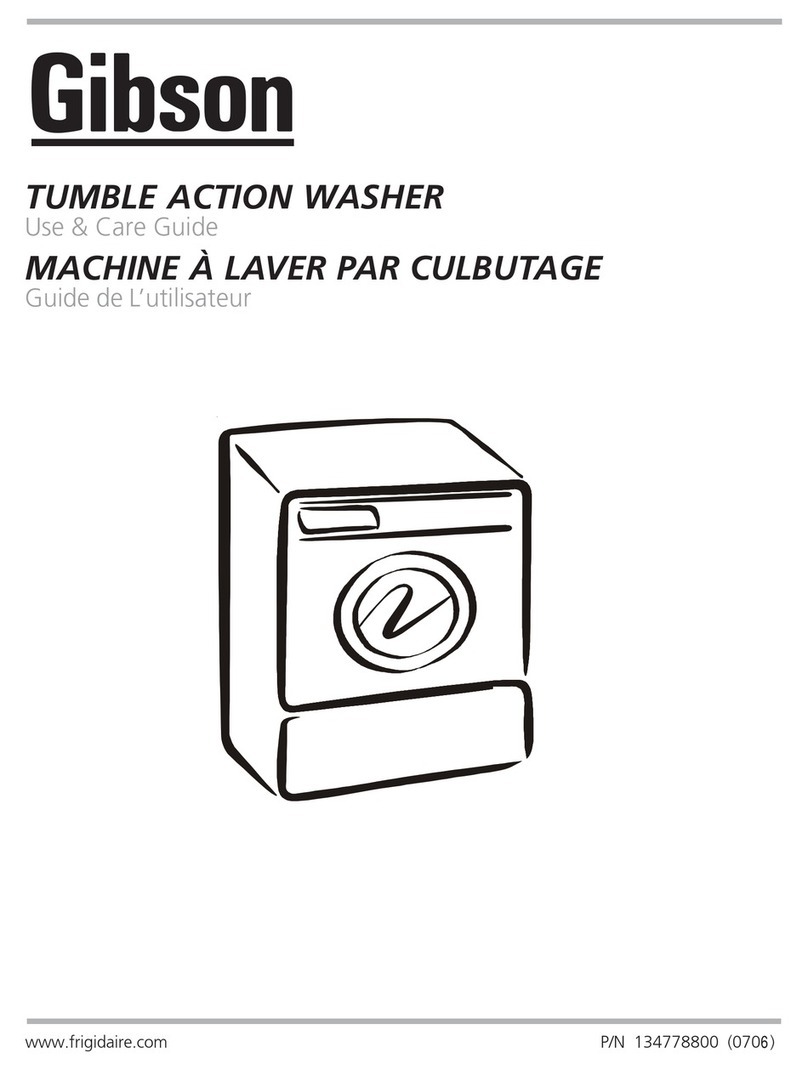
Gibson
Gibson 134778800 Use and care guide

Hotpoint Ariston
Hotpoint Ariston FMD 843 Instructions for use
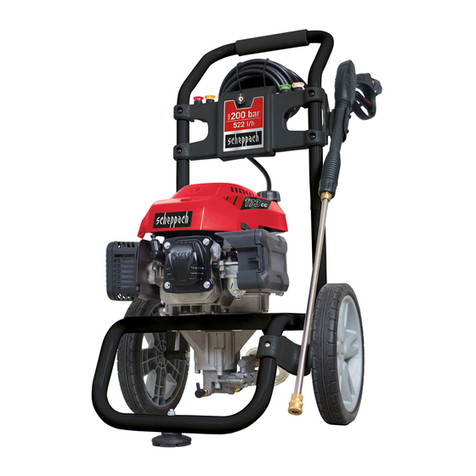
Scheppach
Scheppach HCP2600 Translation of the original instruction manual
